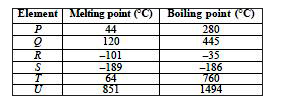The table shows the melting points and boiling points of six elements P, Q, R, S, T and U. These elements represent consecutive members of periods 3 and 4 of the periodic table.

If S is a noble gas, then the bond formed between T and R is
Ionic
Covalent
Coordinate
No bond is formed between T and R.
The correct Answer is:A
Step by step video & image solution for The table shows the melting points and boiling points of six elements P, Q, R, S, T and U. These elements represent consecutive members of periods 3 and 4 of the periodic table. If S is a noble gas, then the bond formed between T and R is by Chemistry experts to help you in doubts & scoring excellent marks in Class 10 exams.
Updated on:21/07/2023Topper's Solved these Questions
Similar Questions
The table shows the melting points and boiling points of six elements P, Q, R, S, T and U. These elements represent consecutive members of periods 3 and 4 of the periodic table.

0.2 mol of the chloride of element U reacts with excess of silver nitrate to form 57.4 g of silver chloride. The formula of chloride is (Given : Atomic mass of N = 14 u, O = 16 u, CI = 35.5 u, Ag = 108 u)
View SolutionThe elements Na, Mg, Al, Si, P, S, Cl and Ar belong to the second period of the Periodic Table.
View Solution
Knowledge Check
The element having lowest melting point in periodic table is
AHgBHeCWDCsThe given table shows a part of the periodic table

P, Q, R, T and U are respectivelyAMg, S, Ar, Al and NeBO,Mg, Ar, P and NeCMg, O, Ne, P and ArDO, Mg, Ne, P and ArPoint out the wrong statement
In a given period of the periodic table the s-block element has, in general, a lower value ofAelectronegativityBatomic radiusCionization energyDelectron affinity
The table given below shows the mass number and number of neutrons in four elements P, Q< R and S

Write down electronic configurations of P, Q, R and S
View SolutionChlorine is an element in period 3 of the Periodic Table. Bromine is found in period 4 of the Periodic Table. These two elements may be from different periods of the periodic table, but they have many similar properties.

Lithium is an element from Group I of the Periodic Table. Write the formula of the compound formed between lithium and
(i) Chlorine (ii) Bromine (iii) What type of bonding is found in these compounds ? Give reason.
View SolutionThe table given below shows the mass number and number of neutrons in four elements P, Q< R and S

To which periods do P, Q, R and S belong?
View SolutionThe positions of three elements P, Q and R in the periodic table are shown below

Which of these three elements is most non-metallic ?
View SolutionPoint out the wrong statement
In a given period of the periodic table the s-block element has, in general, a lower value of
View Solution
